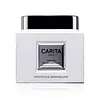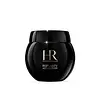What's inside
What's inside
 Key Ingredients
Key Ingredients

 Benefits
Benefits

 Concerns
Concerns

 Ingredients Side-by-side
Ingredients Side-by-side

Water
Skin ConditioningDimethicone
EmollientHydroxypropyl Tetrahydropyrantriol
Skin ConditioningPropylene Glycol
HumectantIsohexadecane
EmollientDimethicone/PEG-10/15 Crosspolymer
Glycerin
HumectantSynthetic Wax
AbrasiveAluminum Starch Octenylsuccinate
AbsorbentDipropylene Glycol
HumectantLauryl PEG-9 Polydimethylsiloxyethyl Dimethicone
Skin ConditioningPhenoxyethanol
PreservativeMagnesium Sulfate
Synthetic Fluorphlogopite
Caprylyl Glycol
EmollientTourmaline
Silica Silylate
EmollientCI 77891
Cosmetic ColorantMadecassoside
AntioxidantCellulose
AbsorbentHydrolyzed Hyaluronic Acid
HumectantCapryloyl Salicylic Acid
ExfoliatingTrisodium Ethylenediamine Disuccinate
Sodium Hyaluronate
HumectantAdenosine
Skin ConditioningSodium Citrate
BufferingLimonene
PerfumingManganese Gluconate
Skin ConditioningMagnesium Gluconate
Skin ConditioningCitronellol
PerfumingTin Oxide
AbrasiveTocopherol
AntioxidantLinalool
PerfumingCI 14700
Cosmetic ColorantParfum
MaskingWater, Dimethicone, Hydroxypropyl Tetrahydropyrantriol, Propylene Glycol, Isohexadecane, Dimethicone/PEG-10/15 Crosspolymer, Glycerin, Synthetic Wax, Aluminum Starch Octenylsuccinate, Dipropylene Glycol, Lauryl PEG-9 Polydimethylsiloxyethyl Dimethicone, Phenoxyethanol, Magnesium Sulfate, Synthetic Fluorphlogopite, Caprylyl Glycol, Tourmaline, Silica Silylate, CI 77891, Madecassoside, Cellulose, Hydrolyzed Hyaluronic Acid, Capryloyl Salicylic Acid, Trisodium Ethylenediamine Disuccinate, Sodium Hyaluronate, Adenosine, Sodium Citrate, Limonene, Manganese Gluconate, Magnesium Gluconate, Citronellol, Tin Oxide, Tocopherol, Linalool, CI 14700, Parfum
Water
Skin ConditioningPropylene Glycol
HumectantDimethicone
EmollientHydroxypropyl Tetrahydropyrantriol
Skin ConditioningIsohexadecane
EmollientCyclohexasiloxane
EmollientGlycerin
HumectantSynthetic Wax
AbrasiveDimethicone/PEG-10/15 Crosspolymer
Aluminum Starch Octenylsuccinate
AbsorbentVaccinium Myrtillus Fruit Extract
Skin ConditioningSodium Hyaluronate
HumectantMagnesium Sulfate
Dipotassium Glycyrrhizate
HumectantDisodium EDTA
Lauryl PEG-9 Polydimethylsiloxyethyl Dimethicone
Skin ConditioningEthylhexyl Hydroxystearate
EmollientAcrylonitrile/Methyl Methacrylate/Vinylidene Chloride Copolymer
Phenoxyethanol
PreservativeCI 77163
Cosmetic ColorantParfum
MaskingWater, Propylene Glycol, Dimethicone, Hydroxypropyl Tetrahydropyrantriol, Isohexadecane, Cyclohexasiloxane, Glycerin, Synthetic Wax, Dimethicone/PEG-10/15 Crosspolymer, Aluminum Starch Octenylsuccinate, Vaccinium Myrtillus Fruit Extract, Sodium Hyaluronate, Magnesium Sulfate, Dipotassium Glycyrrhizate, Disodium EDTA, Lauryl PEG-9 Polydimethylsiloxyethyl Dimethicone, Ethylhexyl Hydroxystearate, Acrylonitrile/Methyl Methacrylate/Vinylidene Chloride Copolymer, Phenoxyethanol, CI 77163, Parfum
Ingredients Explained
These ingredients are found in both products.
Ingredients higher up in an ingredient list are typically present in a larger amount.
Aluminum Starch Octenylsuccinate is a synthetic powder used as an absorbent, thickener, and anti-caking agent.
As an absorbent, it is great at mattifying skin by soaking up the oil. This is why you'll find it in a range of products from makeup to moisturizers.
This ingredient is considered a modified starch. Starch can also be found naturally in plants.
One study from 1991 found that 5% of this ingredient enhanced titanium dioxide SPF by as much as 40%. The study found 1% titanium dioxide had a 5.6 SPF and adding 5% of aluminum starch octenylsuccinate boosted it to an SPF of 8.1
Although “aluminum” in an ingredient name can raise red flags for some consumers, the form and usage context matter significantly. For typical topical applications, there is no substantial evidence of health risks - such as cancer, neurotoxicity, or systemic “aluminum overload.”
Learn more about Aluminum Starch OctenylsuccinateDimethicone is a type of synthetic silicone created from natural materials such as quartz.
What it does:
Dimethicone comes in different viscosities:
Depending on the viscosity, dimethicone has different properties.
Ingredients lists don't always show which type is used, so we recommend reaching out to the brand if you have questions about the viscosity.
This ingredient is unlikely to cause irritation because it does not get absorbed into skin. However, people with silicone allergies should be careful about using this ingredient.
Note: Dimethicone may contribute to pilling. This is because it is not oil or water soluble, so pilling may occur when layered with products. When mixed with heavy oils in a formula, the outcome is also quite greasy.
Learn more about DimethiconeDimethicone/PEG-10/15 Crosspolymer is a type of silicone.
Glycerin is already naturally found in your skin. It helps moisturize and protect your skin.
A study from 2016 found glycerin to be more effective as a humectant than AHAs and hyaluronic acid.
As a humectant, it helps the skin stay hydrated by pulling moisture to your skin. The low molecular weight of glycerin allows it to pull moisture into the deeper layers of your skin.
Hydrated skin improves your skin barrier; Your skin barrier helps protect against irritants and bacteria.
Glycerin has also been found to have antimicrobial and antiviral properties. Due to these properties, glycerin is often used in wound and burn treatments.
In cosmetics, glycerin is usually derived from plants such as soybean or palm. However, it can also be sourced from animals, such as tallow or animal fat.
This ingredient is organic, colorless, odorless, and non-toxic.
Glycerin is the name for this ingredient in American English. British English uses Glycerol/Glycerine.
Learn more about GlycerinWe don't have a description for Hydroxypropyl Tetrahydropyrantriol yet.
Isohexadecane is added to enhance texture, emulsify, and to help cleanse. It is an isoparrafin. It is a component of petrolatum.
Due to its large size, Isohexadecane is not absorbed by the skin. Instead, it sits on top and acts as an emollient. Emollients help keep your skin soft and smooth by trapping moisture within.
Isohexadecane is often used in products designed to help oily skin. It is lightweight and non-greasy while helping to moisturize. When mixed with silicones, it gives a product a silky feel.
Learn more about IsohexadecaneLauryl PEG-9 Polydimethylsiloxyethyl Dimethicone is a type of silicone.
Magnesium Sulfate is a salt. More specifically, it is an epsom salt, or the bath salt used to help relieve muscle aches.
Despite having ‘sulfate’ in the name, it isn’t a surfactant or cleansing agent like sodium lauryl sulfate. Unlike those sulfates, magnesium sulfate doesn’t have the same cleansing or foaming properties (it's simply a type of salt).
In cosmetics, Magnesium Sulfate is used to thicken a product or help dilute other solids. It is a non-reactive and non-irritating ingredient.
One study shows magnesium deficiency may lead to inflammation of the skin. Applying magnesium topically may help reduce inflammation.
You can find this ingredient in sea water or mineral deposits.
Learn more about Magnesium SulfateParfum is a catch-all term for an ingredient or more that is used to give a scent to products.
Also called "fragrance", this ingredient can be a blend of hundreds of chemicals or plant oils. This means every product with "fragrance" or "parfum" in the ingredients list is a different mixture.
For instance, Habanolide is a proprietary trade name for a specific aroma chemical. When used as a fragrance ingredient in cosmetics, most aroma chemicals fall under the broad labeling category of “FRAGRANCE” or “PARFUM” according to EU and US regulations.
The term 'parfum' or 'fragrance' is not regulated in many countries. In many cases, it is up to the brand to define this term.
For instance, many brands choose to label themselves as "fragrance-free" because they are not using synthetic fragrances. However, their products may still contain ingredients such as essential oils that are considered a fragrance by INCI standards.
One example is Calendula flower extract. Calendula is an essential oil that still imparts a scent or 'fragrance'.
Depending on the blend, the ingredients in the mixture can cause allergies and sensitivities on the skin. Some ingredients that are known EU allergens include linalool and citronellol.
Parfum can also be used to mask or cover an unpleasant scent.
The bottom line is: not all fragrances/parfum/ingredients are created equally. If you are worried about fragrances, we recommend taking a closer look at an ingredient. And of course, we always recommend speaking with a professional.
Learn more about ParfumPhenoxyethanol is a preservative that has germicide, antimicrobial, and aromatic properties. Studies show that phenoxyethanol can prevent microbial growth. By itself, it has a scent that is similar to that of a rose.
It's often used in formulations along with Caprylyl Glycol to preserve the shelf life of products.
Propylene Glycol is an odorless, colorless liquid. As a humectant, it helps skin retain moisture. It also aids in delivering active ingredients.
Another role of this ingredient is preventing a product from melting or freezing. Propylene glycol also adds antimicrobrial properties to a product, elongating product lifespan.
This ingredient is considered an organic alcohol and commonly added into both cosmetics and foods.
Those with sensitive skin or conditions may develop a rash when using this ingredient.
Learn more about Propylene GlycolSodium Hyaluronate is hyaluronic acid's salt form. It is commonly derived from the sodium salt of hyaluronic acid.
Like hyaluronic acid, it is great at holding water and acts as a humectant. This makes it a great skin hydrating ingredient.
Sodium Hyaluronate is naturally occurring in our bodies and is mostly found in eye fluid and joints.
These are some other common types of Hyaluronic Acid:
Learn more about Sodium HyaluronateSynthetic Wax is created from fossil fuels such as natural gas. It is used to enhance texture, adjust pH, and as an occlusive.
It may also be used as an abrasive ingredient to exfoliate the skin.
Synthetic Wax may not be fungal acne safe.
Learn more about Synthetic WaxWater. It's the most common cosmetic ingredient of all. You'll usually see it at the top of ingredient lists, meaning that it makes up the largest part of the product.
So why is it so popular? Water most often acts as a solvent - this means that it helps dissolve other ingredients into the formulation.
You'll also recognize water as that liquid we all need to stay alive. If you see this, drink a glass of water. Stay hydrated!
Learn more about Water